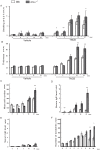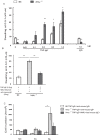Epidermal Neuromedin U Attenuates IgE-Mediated Allergic Skin Inflammation
- PMID: 27463114
- PMCID: PMC4963095
- DOI: 10.1371/journal.pone.0160122
Epidermal Neuromedin U Attenuates IgE-Mediated Allergic Skin Inflammation
Abstract
Although keratinocyte-derived neuropeptide neuromedin U (NMU) mediates the proinflammatory effects of innate-type mast cell activation, no information is available on the physiological roles. Here, to investigate the effects of NMU on IgE-mediated allergic skin inflammation, we determined whether IgE-mediated inflammation associated with severe scratching was induced in Nmu-/- mice administered repeated hapten applications to the ear or footpad. Dry skin was induced by targeted deletion of Nmu. Mice administered repeated hapten application developed IgE-mediated allergic inflammation characterized by severe scratching and increased serum IgE levels only when the ear, and not the footpad, was subjected to scratching, indicating that depletion of NMU from the epidermis alone does not drive such allergic inflammation. Thus, the susceptibility of Nmu-/- mice to allergic inflammation depends primarily on scratching dry skin. Further, allergic skin inflammation mediated by FcεRI cross-linking in Nmu-/-mice was inhibited by prior injection of NMU. These results indicate that NMU plays an important physiological role as a negative regulator during the late stage of IgE-mediated allergic skin inflammation.
Conflict of interest statement
Figures






Similar articles
-
Neuromedin U: potential roles in immunity and inflammation.Immunology. 2021 Jan;162(1):17-29. doi: 10.1111/imm.13257. Epub 2020 Sep 16. Immunology. 2021. PMID: 32888314 Free PMC article. Review.
-
The role of IgE and repeated challenge in the induction of persistent increases in scratching behavior in a mouse model of allergic dermatitis.Eur J Pharmacol. 2009 Mar 1;605(1-3):153-7. doi: 10.1016/j.ejphar.2009.01.006. Eur J Pharmacol. 2009. PMID: 19248227
-
The neuropeptide neuromedin U promotes inflammation by direct activation of mast cells.J Exp Med. 2005 Jul 18;202(2):217-24. doi: 10.1084/jem.20050248. Epub 2005 Jul 11. J Exp Med. 2005. PMID: 16009716 Free PMC article.
-
Over-expression of Truncated IK Ameliorates Dinitrochlorobenzene-Induced Allergic Contact Dermatitis Lesions in BALB/c Mice.In Vivo. 2025 May-Jun;39(3):1378-1393. doi: 10.21873/invivo.13941. In Vivo. 2025. PMID: 40294983 Free PMC article.
-
Attainments in atop: special aspects of allergy and IgE.Adv Pediatr. 2002;49:273-97. Adv Pediatr. 2002. PMID: 12214775 Review.
Cited by
-
Neuromedin U: potential roles in immunity and inflammation.Immunology. 2021 Jan;162(1):17-29. doi: 10.1111/imm.13257. Epub 2020 Sep 16. Immunology. 2021. PMID: 32888314 Free PMC article. Review.
References
-
- Palmer CN, Irvine AD, Terron-Kwiatkowski A, Zhao Y, Liao H, Lee SP et al. Common loss-of-function variants of the epidermal barrier protein filaggrin are a major predisposing factor for atopic dermatitis. Nat Genet. 2006; 38: 441–446. - PubMed
-
- Miyamoto T, Nojima H, Shinkado T, Nakahashi T, Kurahashi Y. Itch-associated response induced by experimental dry skin in mice. Jpn J Phamacol. 2002; 88: 285–292. - PubMed
-
- Lee CH, Chuang HY, Shih CC, Jong SB, Chang CH, Yu HS. Transepidermal water loss, serum IgE and β-endorphin as important and independent biological markers for development of itch intensity in atopic dermatitis. Br J Dermatol. 2006; 154: 1100–1107. - PubMed
MeSH terms
Substances
LinkOut - more resources
Full Text Sources
Other Literature Sources
Molecular Biology Databases

